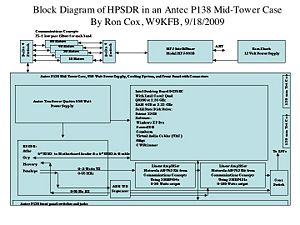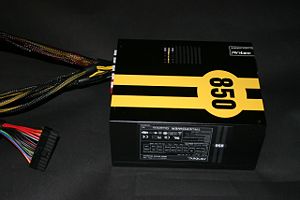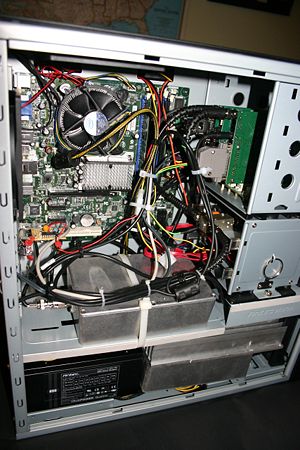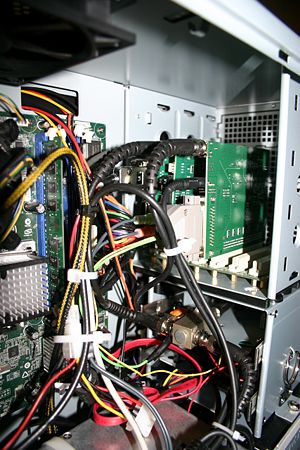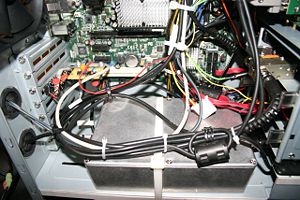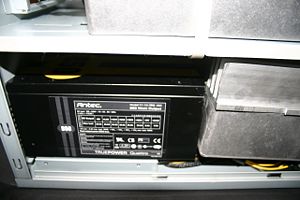Difference between revisions of "The Antec P183 Solution"
(Enclosure details added) |
(rearranged photos and started power supply) |
||
| Line 1: | Line 1: | ||
| + | [[Image:P138Solution.jpg|thumb|300px| Block Diagram of the P138 Solution]] | ||
| + | |||
An example of '''The Antec P183 Solution''' using the [[MERCURY|Mercury]], [[PENELOPE|Penelope]], and [[OZY|Ozy]] boards and other available hardware and software. | An example of '''The Antec P183 Solution''' using the [[MERCURY|Mercury]], [[PENELOPE|Penelope]], and [[OZY|Ozy]] boards and other available hardware and software. | ||
| Line 6: | Line 8: | ||
By Ron Cox, [[User:W9KFB|W9KFB]] (with help from the HPSDR group who made all this possible) | By Ron Cox, [[User:W9KFB|W9KFB]] (with help from the HPSDR group who made all this possible) | ||
| − | + | ||
===Enclosure=== | ===Enclosure=== | ||
| + | [[Image:P138ready.jpg|thumb|300px| Rear view of Antec P138 case prepared for installation of HPSDR components]] | ||
Antec's P183 case brings you top performance and unique style, with its three-layer, sound-deadening panels. Inside, a separate lower chamber houses your power supply (purchased separately), isolating its heat and reducing system noise. The upper chamber comes standard with rear and top 120 mm TriCool fans, with spaces for an optional front 120 mm fan, and a middle 120 mm fan. These two optional fans were mounted to cool the RF power amplifier components. | Antec's P183 case brings you top performance and unique style, with its three-layer, sound-deadening panels. Inside, a separate lower chamber houses your power supply (purchased separately), isolating its heat and reducing system noise. The upper chamber comes standard with rear and top 120 mm TriCool fans, with spaces for an optional front 120 mm fan, and a middle 120 mm fan. These two optional fans were mounted to cool the RF power amplifier components. | ||
| Line 13: | Line 16: | ||
The three-layer side panel and front door stifle system noise for a quiet experience. Front-mounted ports give you easy access to two USB 2.0 connectors, one IEEE 1394 connector, and audio jacks. Rear panel features external controls for the fans in the upper chamber. | The three-layer side panel and front door stifle system noise for a quiet experience. Front-mounted ports give you easy access to two USB 2.0 connectors, one IEEE 1394 connector, and audio jacks. Rear panel features external controls for the fans in the upper chamber. | ||
| − | You'll have all the room you need to build your HPSDR system in this case, with bays for four external 5.25" drives (used for the HPSDR components), one external 3.5" drive and six internal 3.5" drives. There's space for an ATX motherboard up to 12"(W) x 9.6"(L), seven expansion slots, and rubber-grommeted holes on the rear for coax cable entry and exit. | + | You'll have all the room you need to build your HPSDR system in this case, with bays for four external 5.25" drives (used for the HPSDR components), one external 3.5" drive and six internal 3.5" drives. There's space for an ATX motherboard up to 12"(W) x 9.6"(L), seven expansion slots, and rubber-grommeted holes on the rear for coax cable entry and exit. A built-in cable organizer behind the motherboard tray keeps the cables under control. |
| − | + | ||
| − | + | ||
| + | ===Power Supply=== | ||
[[Image:TruePower Quattro.jpg|thumb|300px| 850 Watt TruePower Quattro power supply used in this project]] | [[Image:TruePower Quattro.jpg|thumb|300px| 850 Watt TruePower Quattro power supply used in this project]] | ||
Revision as of 12:34, 27 September 2009
An example of The Antec P183 Solution using the Mercury, Penelope, and Ozy boards and other available hardware and software.
The goal is to build and operate the highest performance amateur radio transceiver that can be assembled using components documented on this wiki. Specifically in one case/enclosure, the following is expected: A totally integrated transceiver with an integrated standard ATX motherboard computer, HPSDR components, and 180 to 500 watts of power output. Not included would be the keyboard, mouse, flat panel screen, audio amplifier low pass or band filters, and antenna tuner. The transceiver must be mechanically and electrically secure so that one would not hesitate to take one to a field day exercise or a DXpedition as a primary rig.
By Ron Cox, W9KFB (with help from the HPSDR group who made all this possible)
Enclosure
Antec's P183 case brings you top performance and unique style, with its three-layer, sound-deadening panels. Inside, a separate lower chamber houses your power supply (purchased separately), isolating its heat and reducing system noise. The upper chamber comes standard with rear and top 120 mm TriCool fans, with spaces for an optional front 120 mm fan, and a middle 120 mm fan. These two optional fans were mounted to cool the RF power amplifier components.
The three-layer side panel and front door stifle system noise for a quiet experience. Front-mounted ports give you easy access to two USB 2.0 connectors, one IEEE 1394 connector, and audio jacks. Rear panel features external controls for the fans in the upper chamber.
You'll have all the room you need to build your HPSDR system in this case, with bays for four external 5.25" drives (used for the HPSDR components), one external 3.5" drive and six internal 3.5" drives. There's space for an ATX motherboard up to 12"(W) x 9.6"(L), seven expansion slots, and rubber-grommeted holes on the rear for coax cable entry and exit. A built-in cable organizer behind the motherboard tray keeps the cables under control.
